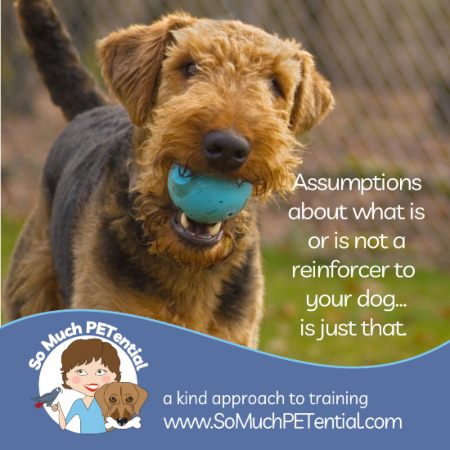One of the greatest gifts that behavior science has given me is the incredible ability to modify behaviors in the least intrusive, most positive way. Often times I can set myself and my pets up for success simply by rearranging the environment to make the wanted behavior easier than the unwanted behavior.
Sound confusing? It is really not.
The ABC’s
I write a lot about the ABCs of behavior. It is the foundation from which I analyze what my pet is doing and what in the environment is influencing his learning.
 Applied Behavior Analysis is a systematic approach to solving behavior problems by changing the environment in which the behavior occurs. It involves looking at the very specific behavior (such as a dog barking) in terms of what is giving that behavior purpose and value? What happened *immediately* prior to the behavior (antecedent) to set the whole ball rolling? And what happened *immediately* after the behavior to reinforce it (consequence)? It is how I have been taught to look at behavior.
Applied Behavior Analysis is a systematic approach to solving behavior problems by changing the environment in which the behavior occurs. It involves looking at the very specific behavior (such as a dog barking) in terms of what is giving that behavior purpose and value? What happened *immediately* prior to the behavior (antecedent) to set the whole ball rolling? And what happened *immediately* after the behavior to reinforce it (consequence)? It is how I have been taught to look at behavior.
I’m going to focus on the A (antecedent) in this article. It’s important to note that antecedents do not cause behavior. However, they do serve as a sign to the animal that when A is there, that if the animal does a certain behavior, then there will be a consequence.
The implications of understanding this are huge. Here are some ways I can use antecedent arrangement as an effective, non-intrusive and positive way of setting my pets up for success:
 Knowing that my bird, Chester (he passed away), was an incessant chewer who could easily destroy furniture (and did a long time ago), I changed the setting of his environment and provided him parrot enrichment activities. I made play stations on the floor to keep him mentally and physically stimulated if he got on the floor. I also weakened his motivation for coming off his cage by giving him lots to chew on inside and outside his cage.
Knowing that my bird, Chester (he passed away), was an incessant chewer who could easily destroy furniture (and did a long time ago), I changed the setting of his environment and provided him parrot enrichment activities. I made play stations on the floor to keep him mentally and physically stimulated if he got on the floor. I also weakened his motivation for coming off his cage by giving him lots to chew on inside and outside his cage.
To eliminate any possibility of my bird, Barnaby, from chewing on the window shade near his play cage, I moved the cage away a couple additional inches.
To prevent a puppy from grabbing onto my sweater, I can avoid wearing loose sweaters around that puppy or I can have a toy in my hand and make the toy very exciting or I can avoid sitting or laying on the ground near the puppy.
To prevent our dog, Sam, from barking at neighbors’ dogs, I can avoid leaving him outside by himself and unattended for long periods of time. (and also give him enrichment toys and more exercise…but that is another article)
Next time your pet is doing something you do not like, ask yourself, “Can I rearrange the environment somehow to prevent that behavior from occurring in the first place?”
Your answer may be the difference between your calling your pet ‘brilliant’ and calling him ‘stubborn.’ And I’d prefer brilliance any day.






